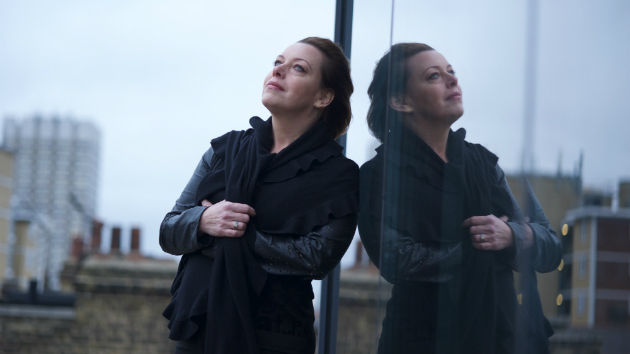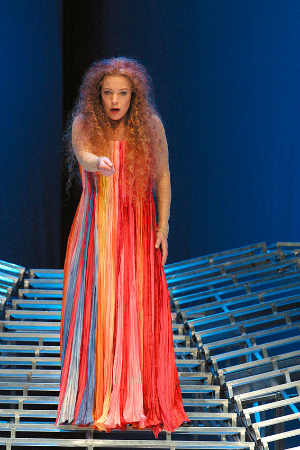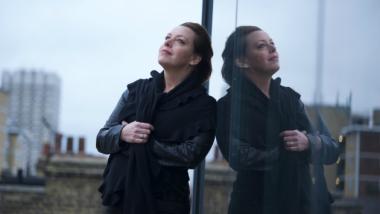
June has been a rich month for music in the city by the Bay, and no performance has been more highly anticipated than that of the woman some call the world’s reigning dramatic soprano in the title role of Fidelio at the San Francisco Symphony. Nina Stemme will sing the role Thursday, June 25, and Sunday, June 28.
Stemme also sang the role at Vienna’s Staatsoper earlier this month, and the role of Turandot at Milan’s La Scala in May, a role she will reprise later this summer for Dalhalla Opera, a grand, outdoor venue in her native Sweden. This is an appropriately demanding cap to a season in which Stemme gave her much lauded and eagerly awaited first performance in her vocal category’s most difficult role, Strauss’s Elektra, which she did in Vienna in March. She will sing her first Elektra at the Metropolitan Opera next season.
Twice named Opernwelt Singer of the Year, the Austrian Kammersängerin has a reputation as hardworking and down-to-earth. During a phone interview on a recent morning, the singer gave no impression of feeling harried by a performance schedule that is rigorous in the extreme.
You sing some of the most physically demanding music in the repertoire, and yet you seem at ease onstage, not as if you’re working very hard to sing. How is it that possible?
Well, that’s part of my training when I learn these demanding roles, that I make it look as if it just came out of me here and now. I have to just give birth to the music again and again, and it’s something that I like to just transmit, so to say. Why should it look difficult? And also for me, I notice that it becomes more difficult if I make it look difficult, instead of letting all the actions that I need to take happen on the inside, because it’s all about breath control. There are strong emotions, too, and I hope I don’t stop them from coming out.
There’s an illustrious lineage of Swedish singers. Is there what you would call a Swedish technique, and if so, what is that?
No, there is no Swedish technique. Maybe there is a Swedish mentality that can absorb this technique, but it’s actually the bel canto technique stemming from [19th-century singer and pedagogue Manuel] Garcia. And then, at the time of Kirsten Flagstad and even Birgit Nilsson, we had great vocal coaches in Sweden and my coach has been studying what they were teaching.
I will quote you to yourself. You said, “I don’t agree that it’s the size of the house. It’s more the size of the attention that gets the pressure on you.” And you also have said, “I have no interest in being a media product.” Is that part of how you keep the pressure off, by not allowing yourself to become a media product?
I don’t know. I do what I think is best for me and my family. It’s also part of, maybe, the sacrifice, because it does take a lot of energy to have the media attention on you all the time, instead of giving all you’ve got on stage. And also, the expectations that you believe people have of you may hinder me from exploring new areas of my voice and artistry. I don’t want to play it safe. And that puts a lot of pressure on me from my own side. Because I’m constantly learning new parts and projects, I don’t really have the time that media project would require.
I’m learning Elektra now for a concert. Do you have any tips for me? Can you offer me any help?
[Laughs.] I wish I could. It’s just hard. You need to do it, many times. To learn how to pace it while you’re there on stage. You can’t believe how one scene comes after the other. It’s just extremely hard, and also difficult to learn the music, but with Strauss, once you’ve learned it, it’s there. He really knew how to write for the soprano voice.
The dramatic soprano is a late-blooming voice type. Do you feel yourself a late bloomer in other ways? I would imagine this is a very full, wonderful time for you.
You’re never safe. You’re never secure. You never know how the voice goes. For instance, once you’ve sung Elektra, and now I’m in the Fidelio realm again, that is difficult. I try to stay humble and see where the voice and the technique takes me from here. It is, actually. You’re never safe. You’re never secure. You never know how the voice goes. For instance, once you’ve sung Elektra, and now I’m in the Fidelio realm again, that is difficult. I try to stay humble and see where the voice and the technique takes me from here. But I’m very fortunate to have this time of my career now – the children are almost grown up – and that I could adapt the technique to take on this repertoire. It’s wonderful as you get older.
You spoke of going back to the Fidelio after Elektra, and you’ve also got Turandot going on. How do you put the horses back in the barn for Fidelio after you’ve done something like Turandot?
I don’t know. It’s difficult. I think this is the last time I’ll sing Fidelio, actually. Because the voice does get a bit broader with Elektra and Turandot, although the tessitura is higher with Turandot, but the ending of Fidelio is actually better than the beginning because the beginning is very lyric from the Vienna classicism time and then it goes more and more towards romantic music, in the Beethoven style of course, as the opera proceeds. So it’s really hard work, full of discipline, and at the same time this opera and this subject of Fidelio is so heartwarming and emotional, I have to be careful not to overdo it, but we need to do it and sing it emotionally.
Do you feel better after a performance of Fidelio than you do after a performance of Salome, because Leonore is so heroic and Salome is so troubled? Does it carry over?
It’s just a pure physical excitement and work you’ve been going through that still pumps around in your body in the form of adrenalin. It takes a while to unwind. I guess you are full of hope. On the other hand, if I do Salome, I’m more into her character and I find it’s, what’s the word…Erlösung. (Salvation) for her to die, so in a way, I get rid of her. It’s strange, because when I sang the Marschallin for instance, she kept living on in me, in a way, after a performance. Fidelio, of course you’re quite euphoric. Although the part is shorter, it’s equally difficult to unwind after Salome. It’s just a pure physical excitement and work you’ve been going through that still pumps around in your body in the form of adrenalin. It takes a while to unwind.
You’ve said that your “head is full of dreams and projects,” What are you dreaming of next?
I’m dreaming of having time to learn the new opera we’re doing in Göteborg. We’re doing an opera on the film Notorious by Hitchcock, so I have to learn the role of Alicia and she’s on stage almost all the time. You know my schedule from this season: first I learned music for a concert and Elektra, and now Notorious, so it’s full. Then, in a couple of years you have Kundry and die Färberin in Frau Ohne Schatten.
Your next opera is based on a film and you did that wonderful production of Fanciulla del West that began with a projection of you as Minnie, as if you were starring in an old western. Are you a movie fan?
I am, but I still feel as if I have so much to catch up in viewing movies. So many directors make references to different movies, so there’s a whole language I still need to learn, and it’s a perfect thing to do when you’re in your apartment in a new city or something. If I hadn’t so much to study, I would take much more time to watch movies.
I heard you sing two Isoldes at the Deutsche Oper last season, and for one of them, you were quite ill.
Oh yes, that was terrible.
They made an announcement before the curtain that they were trying to get someone to take over for you, but then you sang the whole performance and it was exquisite. You were wonderful. And I say that having heard you do it when you were 100 percent. What is that like?

What can you do? I was in contact with a doctor who was a very experienced one. I don’t know what he gave me. [Laughs.] We checked the voice, and he had the same checkpoint as I. The vocal cords weren’t really harmed, it was swollen around. So then you can sing, and I know I have very broad margins when I sing. I felt terrible. I was sweating, I had a fever, but the Randstimme, the very edges of the cords, they were fine so I could sing everything in piano. I think it was the lower range that was affected more. I even had the top C’s, I think.
I heard your Wesendonck Lieder in Berlin a couple of years ago, and you wore this dark purple dress with white geometric patterns on it and it had this little matching jacket. It was stunning. Who made that dress for you, and do you like that part of the job, the gowns and what not?
This is a very interesting dress. It’s a Swedish designer, Camilla Thulin, who made it using Ikat, this special Turkish weaving method where the threads are pre-dyed and somehow, I don’t know how they do it, every thread is in three different colors and then they put it together and that is why the pattern is a little blurry.
Of course you can’t wear a dress like that too often, and it doesn’t suit every kind of music. Now, I found another fantastic designer in Stockholm who actually knows my body and that is perfect, and I can just tell him I’d like a dress like this or that and he comes with it. That is wonderful, that’s taken about 18 or 20 years to find one.
I heard that you went to explore Calistoga. How are you enjoying California?
We enjoy every minute of it. Especially Calistoga, where it is much warmer than San Francisco. [Laughs.] I am here with my whole family. When they heard I got the offer to sing these concerts, they said, “We’re coming with you.”
I have a source that tells me that you famous Swedish divas get together to eat gorgonzola on toast and drink wine.
[Laughs.] I haven’t been home enough for these diva meetings.

